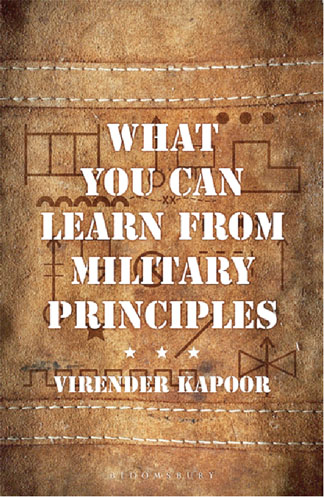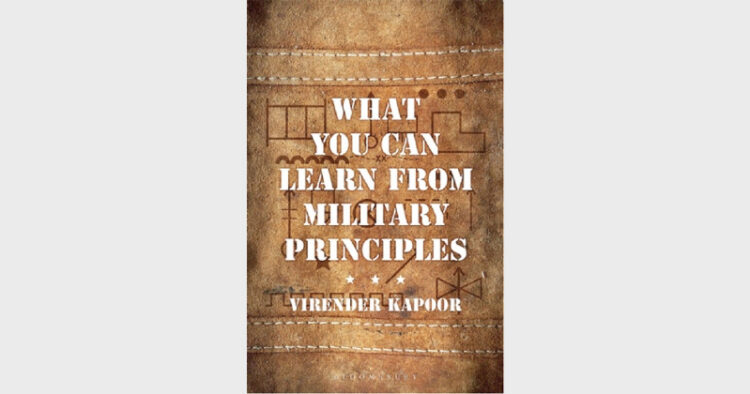 What You Can Learn From Military Principles (Paperback); Virender Kapoor; Bloomsbury India; Pp 270; Rs 399 What You Can Learn From Military Principles (Paperback); Virender Kapoor; Bloomsbury India; Pp 270; Rs 399 |
The book enumerates the value of military principles in our day to day life, increases our insight on various subjects like motivation, leadership, management etc.
P Sandeep
Since time immemorial human beings have fought numerous wars. Due to the catastrophic effects of wars, people consider it a personification of evil and therefore they hate wars. And it is absolutely not a wrong notion or a feeling. But we must not forget the contributions of the wars to the human civilisation. They contributed immensely to the development of science, technology, medicine etc. In the case of India, one of our most celebrated philosophical treaties The Bhagavad Gita is a contribution of a great war, the Mahabharata. And it can be regarded as one of most modern management mantras. Though the war is hated by all, no doubt the instrument of war the military organisations fascinated most of us. Not only the exemplary discipline, cohesion and bravery of soldiers attract us towards them. Their role in defending the nation against all odds including the one at the time of calamities inspires us. The contributions of military organisations to the human race are innumerable.
New ArrivalsFrom Global to Local: The Making of Things and the End of Globalisation (Paperback); Finbarr Livesey; Hachette India; Pp 224; Rs 599 From Global to Local shows how the world trading structure has already begun to shift, with irrevocable consequences for the global economy. If robots can make everything, why would companies use Chinese workers? Power is shifting, trade is shrinking and making things is revolutionising. Finbarr Livesey explores the making of this new world economic order, revealing the processes that lie behind it and showing how no one will be left untouched by its arrival. The Ramayana in Bengali Folk Paintings (Hardcover); Mandakranta Bose; Niyogi Books; Pp 140; Rs 795 The images presented in this book take us into the heart of the rich folk tradition of India. The vividly colourful images presented in this book occupy a special niche in the history of Indian art remarkable because they are not only visual objects but narrative expositions of a text that has been part of the lives of vast numbers of the Indian people and often their source of moral guidance. India’s Most Fearless: True Stories of Modern Military Heroes (Paperback); Shiv Aroor, Rahul Singh; Penguin Random House India; Pp 256 ; Rs 250 The Army major who led the legendary September 2016 surgical strikes on terror launch pads across the LoC; a soldier who killed 11 terrorists in 10 days etc give their own accounts or of those who were with them in their final moments. India’s Most Fearless covers fourteen true stories of extraordinary courage and fearlessness, providing a glimpse into the kind of heroism our soldiers display in unthinkably hostile conditions and under grave provocation. The Golden House (Hardcover); Salman Rushdie; Penguin Random House India; Pp 368; Rs 699 The story of a powerful Golden family is told from the point of view of their neighbour and confidant, René, an aspiring filmmaker who finds in the Goldens the perfect subject. René chronicles the undoing of the house of Golden: the high life of money, of art and fashion, a sibling quarrel, an unexpected metamorphosis, the arrival of a beautiful woman, betrayal and murder and far more, in India, the unravelling of an insidious plot. |
The book by Virender Kapoor, named What You Can Learn from Military Principle is an excellent piece of work. The book enumerates the value of military principles in our day to day life. He starts the book by referring to the book of Chinese legend Sun Tzu, The Art of War. The treasure-trove opens as the book progresses. In fact, the excerpts of legendary military generals and world leaders incorporated are the most valuable part of the book. And, the insight provided by the author is also remarkable and commendable. In each chapter one portion is dedicated for discussing the utility of military principles in business and management. An historical perspective is also given on the development of war strategies, practices, machines, types of equipment etc. It is an important feature of the book.
One of the interesting subjects discussed in the book is propaganda. It has great significance in our day to day life. The book will give us an overview of its development in the historical perspective, especially its evolution during the World Wars. A comparative analysis of the propaganda strategies of different powers like Germany, Britain, United States, Russia etc. will definitely provide you great insight. According to Kapoor, Nazi Germany invented some of the pioneering methods of propaganda. In fact, Joseph Goebbels was the brine, and inspiration behind the German propaganda machine. British also used propaganda intelligently and extensively during both the world wars. The worldwide communication network they had helped them to win more allies. Kapoor says, initially the American government was not in favour of propaganda. But when they decided to use it, they set all guns blazing and used all available means to achieve their goals. A simple fact mentioned in the book testifies the American attitude. It says “Americans probably used the maximum number of posters, more than any other country involved in the war. More than 2, 00, 000 differently designed posters were used during the period 1941 to 1945”, the sheer number itself is mind-blowing. Americans continued the use of propaganda even after the II world war, and its use was extensive during the cold war. The Russians also used propaganda extensively and systematically but according to Kapoor its impact was minimal on Russian people due to the undemocratic nature of communism. The chapter also discusses about the use of propaganda for various purposes in the modern times. As mentioned in the beginning the book definitely increases our insight on various subjects like motivation, leadership, management etc. But its real significance is the bird’s-eye view it provides on the role of military organisations and principles in the evolution of world order. And it also initiates us to an alternative worldview.














Comments